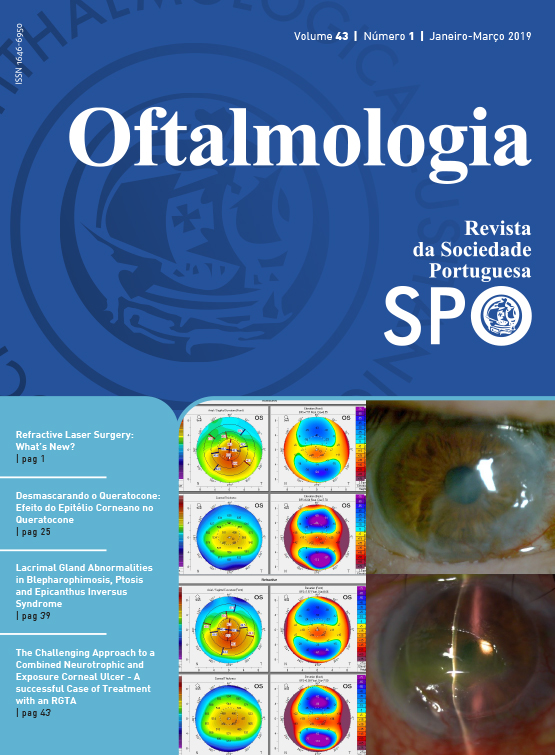The challenging approach to a combined neurotrophic and exposure corneal ulcer - A successful case of treatment with an RGTA
DOI:
https://doi.org/10.48560/rspo.13264Palavras-chave:
corneal neurotrophic ulcer, corneal hypoesthesia, corneal exposure, RGTAResumo
Aim: To describe a challenging clinical case of a patient with a neurotrophic and exposure corneal ulcer.
Case report: A 75-year-old male patient, with history of right eye (RE) limbic stem-cell insuficiency due to complications of recurrent herpetic keratitis, underwent successful limbic stem-cell transplantation in 2008. In 2010, an uneventful penetrating keratoplasty was performed. After a cataract phacoemulsification surgery with intraocular lens implantation done in 2011, best corrected visual acuity was 20/20, and remained stable until 2015. In July 2015, the patient developed right facial nerve palsy and two months later, presented with an extensive central corneal ulcer, with a significant thinning of central stroma, without infection signs, but with an imminent risk of perforation. Treatment with topical ofloxacin and intensive ocular lubrification was started in association with permanent ocular oclusion. Due to lack of any clinical improvement, treatment with RGTA [Poli (carboximetilglucose) sulfate, dextrano T40] was started. After two weeks of treatment, a complete reepithelization and partial stromal filling was observed. Continued monitoring and treatment with artificial tears was maintained, with no recurrence observed.
Conclusion: There is an unmet need for a medical therapy that could help corneal neurotrophic ulcers to heal. The presented clinical case shows that the approach of targeting extracellular matrix can be effective in the reepithelialization of neurotrophic and exposure corneal ulcer that do not respond to conventional treatments.
Downloads
Downloads
Publicado
Como Citar
Edição
Secção
Licença
Não se esqueça de fazer o download do ficheiro da Declaração de Responsabilidade Autoral e Autorização para Publicação e de Conflito de Interesses
O artigo apenas poderá ser submetido com esse dois documentos.
Para obter o ficheiro da Declaração de Responsabilidade Autoral, clique aqui
Para obter o ficheiro de Conflito de Interesses, clique aqui





